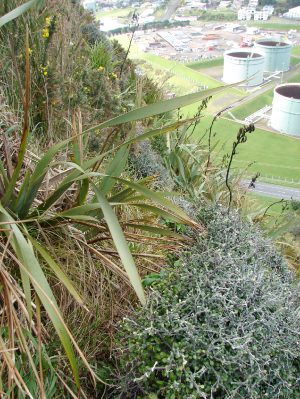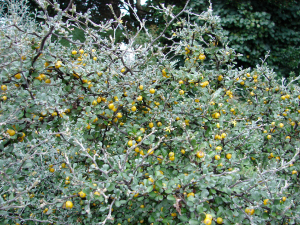Corokia cotoneaster - The Paritutu Korokio
Scientific name: Corokia
cotoneaster (Corokia being
formed from the Maori name for some members of this plant group, korokio, and cotoneaster,
referring to the resemblance of this species to Cotoneaster, an unrelated exotic plant)
Common name: korokio
Family name: Cornaceae (Dogwood family)
The “Paritutu korokio”, (Corokia cotoneaster), is a tangle-branched (divaricating) coastal shrub with rough black branches and branchlets, and greyish-green stems and leaves, the undersurface of which are thickly covered in pale greyish-white tomentose (downy hairs). Flowers are yellow and star-shaped and the ‘berries’ (or more technically ‘drupes’- a succulent fruit with the seed enclosed in a bony casing) are yellow to light orange.
The Scottish botanist John Buchanan (1819-1898) first recorded the presence of Corokia cotoneaster on Paritutu in 1869. In more recent times D.S.I.R botanist Tony Druce carried out extensive surveys of the Taranaki Western Coast (1964-1973) and drew attention to a ‘large-leaved’ (up to 2- (3) cm long) and ‘large-flowered’ (up to 1.5cm diameter) coastal variety found on Paritutu, and further north; which it seems has subsequently led to the occasional use of the informal epithet var. “Paritutu”, and the use of Paritutu as a prefix to the common name for this form of Corokia cotoneaster.
Eagle’s Trees & Shrubs of New Zealand (2006) illustrates this form as “Corokia cotoneaster (ii)”. It is recorded as growing naturally in small widely scattered populations on the west coast of the North Island from Paritutu Rock, New Plymouth (the southern limit for this form) to as far north as Aotea Harbour which is north of Kawhia. This coastal form has distinctly different foliage colouration and although variable can have larger leaves, flowers and drupes than other Corokia contoneaster populations in the North and South Island, and never has red drupes like other forms. It is of course also quite different in appearance and habit to the very low growing form from Surville Cliffs, north-west of North Cape, also described by Tony Druce and referred to in Eagle (2006) as “Corokia cotoneaster (v)”.
The “Paritutu korokio”, is still found growing in limited numbers on Paritutu Rock near Port Taranaki. The rock is a 154 metre high eroded remnant of an extinct volcano (from approximately 1.75 million years ago): much older than Mt Taranaki. In pre-European times a portion of the summit was leveled and fortified as a Maori pa and is currently relatively easily accessed via a well maintained stepped and wired track.
On Paritutu the korokio can be seen just below the summit, on the inland side, where it has formed a colony of low spreading divaricating plants of 50 cm high or less, which seem well adapted to the harshness of the location. Its bright yellow star shaped flowers appear from October and are followed some months later by an abundance of yellow fruit.
During Conservation Week in 1999 the New Plymouth office of the Department of Conservation completed a special planting programme to help conserve it. Plants were propagated from seed gathered near the top of Paritutu and over 40 shrubs were returned to the site.
Paritutu, and the adjacent Nga Motu/Sugar Loaf Islands, are a dominant feature of the New Plymouth coastal landscape. The natural vegetation (including other such rarities as the nationally threatened Cook’s Scurvy Grass, Lepidium oleraceum (recorded on Moturoa and Motumahanga islands) is a fundamental component of the character, history and ecology of this landscape. In the past the Paritutu Rock has been considerably altered by human activity. This includes the 1920s dramatic loss of the southern shoulder, and two rocky humps near the north east base, as a result of blasting and quarrying in port development.
The area received a degree of protection when it became part of the Paritutu Centennial Park in 1938 but since then successive plantings of non-local natives and some exotics, especially around the inland side and on sites damaged by fires, has altered the natural vegetation cover considerably. In the past some cultivated forms of Corokia have been planted and DOC has been involved in trying to eliminate these to prevent genetic contamination of the natural form. Also weeds such as gorse are now common on the rock and compete directly with the original indigenous plants while the exotic garden plant Agapanthus orientalis has also invaded the SW flank to considerable height.
Establishment of the Ngamotu/ Sugar Loaf Islands Marine Protection Area in 1991 gave the area due recognition and will hopefully lead to more careful protection of the islands and foreshore in the future.
Photos

Paritutu korokio habitat

Characteristic yellow drupes of the Paritutu korokio
Plant List